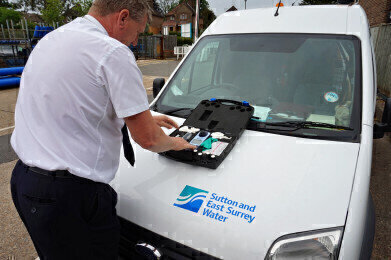Water/Wastewater
The Importance of Quick and Accurate Turbidity Testing for Water Network Suppliers
Aug 10 2016
Sutton and East Surrey Water (SESW) has supplied water to residents of the Sutton and Surrey areas for over 150 years. The company currently covers 835 km2 (322 square miles), supplying 670,000 customers and 282,000 properties.
The problem
Unlike other utilities, SESW softens its borehole abstracted water prior to distribution. While this helps prevent future limescale build-up and protect customers’ property, it does little to abate the historical calcium deposits lining the network mains and communication pipes. These deposits can be disturbed by high flow rates, causing significant turbidity issues if not dealt with properly.
Last year SESW experienced 392 customer complaints about taste, odour and turbidity, missing its target of 350. However, of these events, only 60 were related to SESW’s network activities. A significant number of these events are the result of white and turbid water, stemming from the historical calcium deposits, which can become mobile at flow rates above 10 L/sec.
The biggest challenge to overcome after a network activity is quickly and accurately establishing the turbidity of the mains water before returning it to service. Previously, this had been done visually by the network service teams with a sample collected for lab analysis the next day. However, at low (<10) NTUs (Nephelometric Turbidity Units) it was virtually impossible to be sure if the visual assessment would match the laboratory results – especially when operations were occurring at night.
The solution – turbidity testing
To overcome this issue, SESW decided to equip its network teams with turbidity meters. After trying meters from a number of manufacturers, the Palintest (UK) Turbimeter was selected as it demonstrated the best blend of laboratory and field performance in a package that was quick and easy to use. It allows the SESW team to get quick and accurate results to confidently assess when the mains can be reconnected.
Since introducing the meters the company saw a 15% monthly reduction in customer complaints. However, when looking at water quality events related to network servicing activities, the company projects them to fall to around 16 this year, down from 60 last year – a massive 75% reduction following the introduction of turbidity testing.
The impact of this is not just an improved customer experience but also increased compliance, fewer water quality penalties and improved service incentive mechanism (SIM) ratings, which ensure a minimal payback time on the investment in the meters.
Events
Apr 24 2024 Sao Paulo, Brasil
May 05 2024 Seville, Spain
May 13 2024 Munich, Germany
May 23 2024 Beijing, China
May 23 2024 Beijing, China













